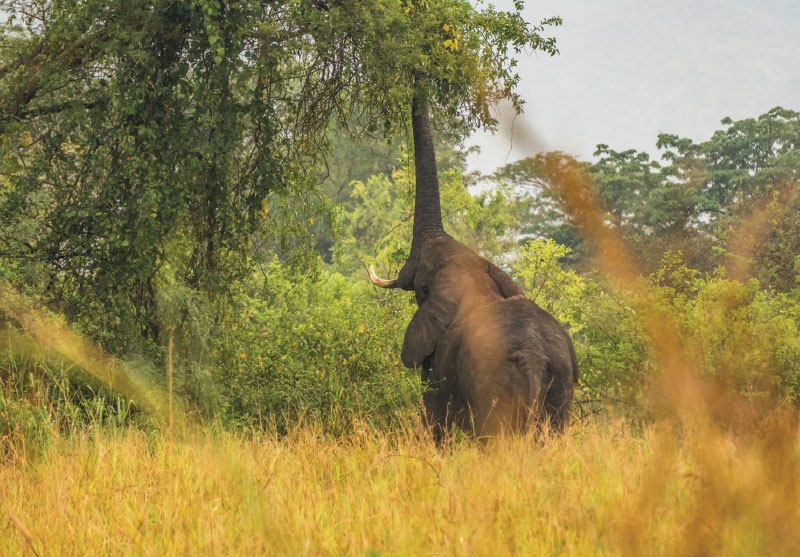Semliki National Park is one of the rarely and less visited National Parks in the country but the mind-blowing things it offers can only be testified by the few nature enthusiasts who take their time to visit it. Are you someone willing to go off the beaten track to experience the beauty of Mother Nature? Then the Semliki Forest National Park should be your next destination during a tour in Uganda.
When you visit this Park, you will go down the steep escarpment of the western Albertine Rift where you will enjoy stunning views of the Mountains of the Moon (at the border), extensive savannah grasslands, Lake Albert, forests and many others. As earlier mentioned, few tourists visit Semuliki compared to the other National Parks but its vast beauty and diversity inform of trees, plants, flowers, mammals, birds and butterfly species make it one of the most beautiful places in the country. Not only that, visitors to this site also get the chance to explore the magnificent Sempaya Hot springs.
The largest part of this Park is comprised of greatly unspoiled lowland forest which is an extension of the vast Ituri Forest that extends from side of the Democratic Republic of Congo across River Semliki. Just like most Parks in Uganda, Semuliki National Park is surrounded by some local communities, especially the Batwa Pygmies (original inhabitants of the Forest) as well as other communities such as Bakonzo, Batuku and Bambwa who migrated to the area over the Centuries.

Savannah Elephant in Semliki Valley
The unforgettable activities to engage in when you visit the Semliki Forest National Park include;
Visiting the Sempaya Hot springs
You discover that Semliki is the only National Park in Uganda that offers tourists with an opportunity of exploring hot springs and this involves undertaking an hour-long trail to the outer male hot spring through a small patch of forest where primates especially black and white colobus monkeys, red-tailed monkeys and the grey-cheeked mangabeys are common but the tree house enroute provides a picturesque view.
Also, the half-hour hike through the palm-dominated forest from the main road leads tourists to the inner female hot spring that is dominated by a hot boiling geyser where plantain, Irish and sweet potatoes as well as eggs can be boiled and enjoyed by hungry trekkers.
Chimpanzee tracking
Did you know you can track Chimpanzees from Semliki National Park? These primates were habituated by Indiana University much as don’t offer high chances of seeing them as it is in Kibale Forest National Park. Just like in other places, the trek begins at 8am and lasts one to 6 hours.
Bird watching
With its remoteness, birders who take their time to the Park are treated to views of some of Africa’s exceptional forest bird species. Ntandi and Sempaya areas offer excellent viewing opportunities of the Ross Turaco, Piping hornbills, Leaf-love, Red-rumped tinkerhead, Chestnut-breasted Negrofinches, white-crested hornbills, Maxwell’s black weavers, Yellow-throated Nicator, Great blue turaco, Crested Malimbe and Red-billed Dwarf hornbills among others. The shoebill is frequently sighted near Lake Albert quarters while areas around River Kirumia are one of the best birding spots.
Game Drives
There are several wildlife species inform of elephants, buffaloes, waterbucks, Uganda kobs, elands and warthogs that can be spotted across the three game tracks across the savannah plains of this Park. There are morning, afternoon and finally the night game drives allow tourists to see the elusive leopards, white-tailed mongoose, bush babies and the pygmy Hippos.
Hiking or Nature walks
Nature walks within Semliki National Park are conducted through the 13-kilometer/8-hour Kirumia Trail that passes through the middle of the Forest to River Semliki and is ideal for bird watchers, the 8 kilometer/2-4 hour Sempaya Nature trail offers views of the striking hot springs and primate species as well as the 11 kilometer Red monkey track that transverses through the eastern edge of the Park to River Semliki and is a refuge for the exceptional DeBrazza’s monkeys.
Cultural visits
Cultural visits are conducted within areas occupied by the Bambuti pygmies that occupy both sides of River Semliki and are closely related to the Basu pygmies of DRC instead of the Batwa of Mgahinga and Bwindi Impenetrable National Parks. Visiting these communities allows them to display their rich cultural history through dance and music performances.

